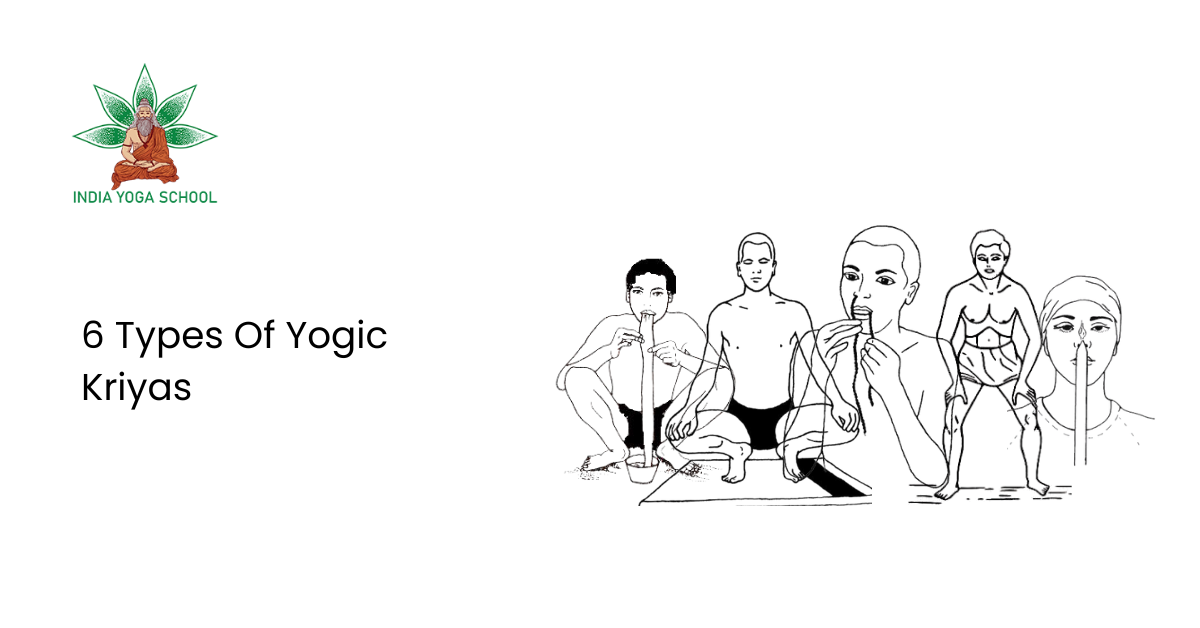Kriyas are pretty significant when it comes to yoga practice and kriyas is an important subject that you can learn at the India Yoga School. If you’re ready to dive deep into the realm of yoga mastery, then this blog by the India Yoga School is definitely for you.
What are these 6 Types of Yogic Kriyas?
As described in the Hatha Yoga Pradipika, the six Yoga Kriyas are collectively referred to as Shat Kriya or Shat Karma. Yoga Kriyas come in six different varieties, each with its own purifying benefits. These 6 yogic kriyas are a wonderful way to improve your immune system by means of prior purification processes and all of them work to cleanse the body of toxins and other harmful substances in order to make it more receptive to the infusion of prana, or life force.
How Do Yogic Kriyas Help You?
There are 11 functional systems inside the human body, including the cardiovascular, respiratory, digestive, urinary, neurological, and endocrine systems. A healthy, disease-free body and mind depend on clean internal organs.
Kriyas are the foundation of our yoga practice because they foster an awareness that extends beyond the body. In order to get the most out of our pranayama, asana, mudra, and meditation sessions, we always begin with these Kriyas.
Six Kriyas or Shat Kriyas that we teach at India Yoga School
Dhauti – The purification of the oral cavity and esophagus
- The Sanskrit word for “washing” is dhauti. The idea behind this technique is to drink until you’re absolutely dehydrated, at which time you’ll throw up whatever poisons that are still in your system.
- Improved digestion and less mucus in the stomach are two of the many benefits of practicing Dhauti Kriya.
- In addition, Kriyas help balance the three doshas, or energy centers, in the body: Kapha, Pitta, and Vata.
- Vamana Dhauti is chugging large quantities of lukewarm water and then vomiting them up to purge the digestive system of harmful substances; this is a common dhauti practice.
- Vastra Dhauti requires holding a piece of clean muslin cloth wet in lukewarm water in one’s stomach for several minutes. The object is then removed from the mouth, taking the waste products of digestion with it.
- Additional practices include tooth brushing (Danta dhauti), tongue scraping (Jihva dhauti), and ear cleaning (Karna dhauti).
Also Read: Outstanding Benefits of Early-Morning Yoga
Basti – Purifying the big intestine / the belly button area.
- It’s a way to refresh the body internally by flushing out the bowels. When doing basti, one uses the anus to take a deep breath of air or water. In Uralic, the term for “to hold” (Basti) refers to the urinary bladder.
- This procedure is useful for addressing problems with digestion, elimination, and gas. Jala Basti is a popular choice among the different types of basti.
- Jala Basti was traditionally performed in a river while crouching. The word “jala” refers to liquid. In this approach of intestinal hygiene, water is used to flush the bowels.
- Utkatasana is performed over a tub filled with water to the navel.
- Get down on your hands and knees and slump.
- Suck the water via the anus into the huge intestines.
- Make a vacuum by inhaling and doing the belly cleansing rituals of Nauli kriya and Uddiyana bandha. As a result, the abdominal muscles tighten and water is drawn into the lower abdomen.
- While standing, keep the water in your stomach for five to thirty minutes.
- Open your anus and breathe the water out.
- As you can see, we’ve gone through one complete cycle. If you want to keep your colon clean, you can do this as often as you like.
- This kriya is quite advanced and should only be practiced under the guidance of an experienced teacher. The last bit of air or water is then expelled through a series of mudras and savasanas.
Neti – The practice of nasal irrigation
- Cleans out the nasal passages and gets rid of any buildup. ‘Prana,’ or life force, enters the body through the nasal passages, thus keeping them clean is essential. This kriya requires a clean neti pot.
Two types of Neti are available:
- Jala Neti is a method of cleansing the nasal passages and removing toxins in which water (jala) is used. To use the neti pot, water is poured into one nostril and allowed to flow out the other. Using water that has exited the opposite nostril to rinse the nasal passages.
- To do this neti, a rubber thread (sutra) is massaged into the nasal passages and used to dislodge any obstructions.
Also Read: Best yoga schools in India
Nauli – A System for Increasing Abdominal Muscle Strength
- This kriya is a sort of abdominal exercise that is meant to stimulate the digestive fire by moving the abdominal muscles.
- This kriya is crucial for maintaining muscle flexibility and physical vitality. Nauli is a cleansing and massaging treatment that benefits the digestive and urinary systems.
- Having everything work as it should improves digestion and hunger. Maintain a slight bend in your knees and stand with your feet hip-width apart.
- Madhya Nauli is the joining of the muscles on the left and right sides into one.
- From a central wall position, the abdominal muscles are aligned to the left in Vama Nauli.
- Dakshina Nauli is accomplished when both of your abdominal muscles are pointing right from the center wall.
Trataka – Eye cleansing
- Trataka Kriya, in which the practitioner stares fixedly at a distant or interior object, is one of the easiest and most effective techniques for cleansing the eyes. The optimum method involves a candle placed at roughly chest height.
- Consistent and challenging exercise improves concentration and helps eliminate distracting thoughts.
- Internal Trataka occurs when focus is directed inside, to the Third eye (the point between the eyebrows). This is also helpful for the sixth chakra (the “third eye” or “Ajna chakra”).
- External Trataka is the practice of fixing one’s attention on something beyond oneself. Think about where you put the candle to see what I mean.
Kapalbhati – Purifying the prefrontal cortex.
- This kriya is the sixth and last one in a series meant to improve cognitive function. Kapalabhati literally translates to “Skull Shining” in English. This cleansing kriya is a pranayama practice used to improve one’s respiratory health, boost one’s energy, and keep one’s mind clear and focused.
- Kapalabhati involves rapid contraction and relaxation of the abdominal wall in sync with the breath.
- The inhale is relaxed, but the out breath is strong. This kriya is best practiced with the legs crossed.
Conclusion
Foundational kriyas, including Kapalbhati, Neti, and Trataka, are taught and practiced by students in India Yoga School’s 200-hour yoga teacher training in Goa. Our training courses cover a wide range of advanced techniques such as Sutra Neti, Vamana Dhauti, and more. Kriyas are best practiced under the guiding instruction of a guru.
They enhance well-being and promote happiness by facilitating a superb equilibrium of the physical body, the respiratory system, and the mental state.







Leave A Comment